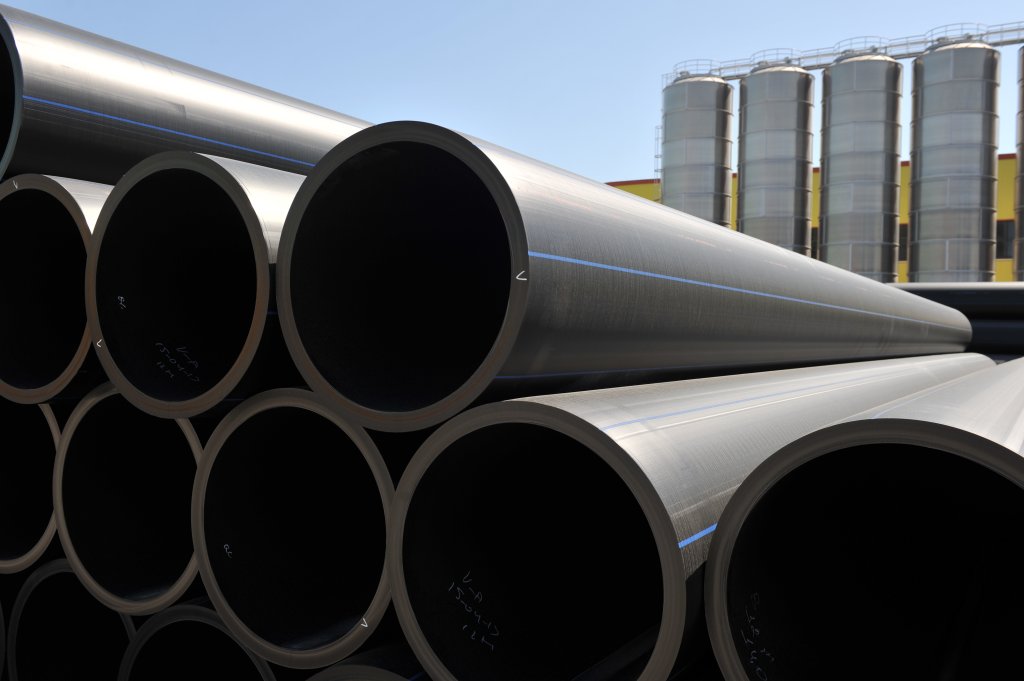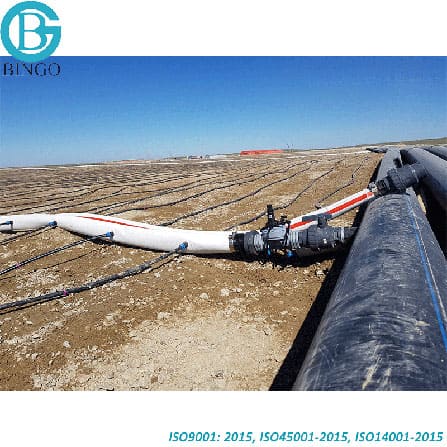American Plastics HDPE Pipe for Oilfield: Built for Harsh Conditions
Wiki Article
Check Out the Production Process Behind High-Quality HDPE Pipeline and Its Applications
The manufacturing procedure of high-quality HDPE pipelines is complex and methodical. It begins with the option of resources that enhance performance. Following this, ethylene goes through polymerization to develop material, which is then formed through extrusion. Quality control is critical, ensuring that the end product fulfills strict standards. The journey of HDPE pipelines doesn't end with production. Their applications across numerous sectors disclose a broader relevance worth examining.Recognizing HDPE: Characteristics and Advantages

High-density polyethylene (HDPE) is a functional thermoplastic known for its resilience and resistance to various environmental variables. This material exhibits exceptional tensile toughness, making it ideal for demanding applications. Its low-density framework contributes to a lightweight item, facilitating convenience of handling and installment. HDPE likewise showcases exceptional resistance to chemicals, which decreases degradation when revealed to rough compounds.
The material's reduced wetness absorption better enhances its longevity, making it suitable for use in pipes and tank. Furthermore, HDPE is immune to ultraviolet (UV) radiation, making sure that products maintain their integrity also when subjected to sunshine. Moreover, its adaptability enables the development of detailed forms without endangering toughness. The eco-friendly nature of HDPE, often stemmed from recycled products, includes in its appeal, advertising lasting techniques in manufacturing. Overall, these residential or commercial properties and advantages make HDPE a favored selection for numerous industrial and consumer applications.
Resources Choice for HDPE Manufacturing
The selection of basic materials for HDPE production is important to confirm the end product meets the desired specifications and quality standards. High-density polyethylene (HDPE) is mainly created from polymerized ethylene, originated from nonrenewable fuel sources such as natural gas or petroleum. The quality of these feedstocks substantially affects the mechanical and thermal residential or commercial properties of the final HDPE.Additives also play a considerable function in enhancing HDPE's efficiency, consisting of antioxidants, UV stabilizers, and colorants, which enhance toughness and resistance to ecological aspects. The selection process must think about not only the chemical composition of the raw materials however additionally their handling characteristics to ensure efficient production.
The sourcing of raw products ought to focus on sustainability and compliance with ecological guidelines, as accountable practices are imperative in today's market. Inevitably, careful basic material choice lays the foundation for generating top quality HDPE pipes suitable for varied applications.
The Extrusion Refine: Forming HDPE Pipe
The extrusion process plays a crucial duty fit HDPE pipelines, starting with meticulous product preparation methods that assure suitable flow and consistency. Equally essential is the layout of the die, which straight influences the last measurements and surface top quality of the pipe. With each other, these factors contribute considerably to the performance and high quality of HDPE pipe manufacturing.Product Prep Work Strategies
Efficient manufacturing of HDPE pipelines begins with precise product prep work techniques, specifically the extrusion procedure. During this phase, high-density polyethylene material is initial dried out to get rid of dampness, making sure suitable flow characteristics. The resin is then fed right into the extruder, where it undertakes home heating and melting, changing into a thick state. This home heating process is meticulously regulated to keep the product's honesty and efficiency. The molten HDPE is required with a die, shaping it into a continuous pipeline kind. Appropriate temperature management throughout extrusion is essential, as it straight influences the product's homes and the final product high quality. As soon as shaped, the HDPE pipe is cooled down and cut to specified lengths, ready for succeeding handling and applications.Die Layout Relevance
Precision in die layout plays an essential function in the extrusion procedure of HDPE pipes. The die functions as the last shaping tool, directly affecting the pipe's dimensions, wall surface thickness, and surface area finish. A properly designed die guarantees uniform product flow, decreasing issues such as abnormalities and weak points. The geometry of the die need to be optimized to fit the particular residential or commercial properties of HDPE, including its thickness and thermal habits during extrusion. Furthermore, the cooling price of the material as it travels through the die can markedly influence the pipeline's architectural honesty. Subsequently, investing in sophisticated die technology is essential for makers intending to create high-quality HDPE pipelines that satisfy industry criteria and client expectations.Quality Control Actions in HDPE Manufacturing
Different factors affect the high quality of HDPE pipeline production, effective quality control steps are crucial to assure uniformity and reliability in the final product (American Plastics HDPE Pipe Manufacturing). Secret quality assurance methods consist of strenuous product inspection, validating that the raw polyethylene fulfills well-known requirements for pureness and density. Throughout the extrusion procedure, parameters such as temperature, stress, and cooling time are very closely checked to preserve dimensional precision and structural integrityIn addition, post-production screening is important; producers typically conduct hydrostatic examinations to assess the pipe's strength and resistance to stress. Visual inspections for surface flaws better enhance quality guarantee. Certification from appropriate requirements companies, like ASTM or ISO, provides an additional layer of integrity. By carrying out these extensive top quality control steps, makers can lessen problems, enhance performance, and make sure that the HDPE pipelines satisfy the particular needs of numerous applications, eventually resulting in consumer contentment and count on the item.
Applications of HDPE Pipe Throughout Industries
HDPE pipes are utilized across different markets due to their longevity and adaptability. In water distribution systems, they ensure effective delivery, while in wastewater administration, they give trusted options for waste transportation. In addition, agricultural irrigation networks take advantage of HDPE's resistance to corrosion and adaptability, making it a perfect choice for contemporary farming techniques.
Water Circulation Systems
A substantial number of sectors depend on high-density polyethylene (HDPE) pipes for reliable water distribution systems. Recognized for their sturdiness and resistance to rust, HDPE pipelines are widely utilized in municipal water system networks, agricultural watering, and industrial applications. Their lightweight nature facilitates very easy handling and setup, minimizing labor prices and time. Furthermore, HDPE pipelines can suit various stress levels, making them ideal for both reduced and high-pressure systems. custom hdpe pipe manufacturing Midland TX. The versatility of the material enables smooth integration into existing framework, reducing the demand for substantial excavation. HDPE's resistance to chemical seeping guarantees that the water provided remains secure and tidy, making it a perfect option for keeping the top quality of drinkable water across different sectors.Wastewater Management Solutions
Effective water distribution systems likewise lead the way for innovative wastewater monitoring options, where high-density polyethylene (HDPE) pipes play a significant role. Prominent for their sturdiness and resistance to rust, HDPE pipelines are ideal for carrying wastewater in various settings. Their flexibility enables very easy installation in complex atmospheres, decreasing the demand for comprehensive excavation. Furthermore, HDPE's smooth indoor surface decreases friction, boosting flow rates and effectiveness. These pipelines are also resistant to chemical leaching, guaranteeing that contaminants do not endanger the surrounding setting. Industries, communities, and therapy centers increasingly rely on HDPE pipelines for their reliability and long life, making them a recommended option for modern-day wastewater administration systems. This versatility highlights the essential value of HDPE pipes across many applications.Agricultural Watering Networks
Agricultural watering networks benefit considerably from making use of high-density polyethylene (HDPE) pipelines, which provide reliable and reputable water shipment to crops. HDPE pipelines are light-weight, making them easy to carry and mount, while their adaptability enables various arrangements in varied surfaces. These pipelines demonstrate exceptional resistance to deterioration, chemicals, and UV radiation, ensuring longevity in extreme agricultural atmospheres. Additionally, their smooth interior surface lessens rubbing loss, enhancing water flow and minimizing power expenses connected with pumping. The long life of HDPE pipes, usually surpassing half a century, adds to decrease upkeep and replacement expenditures. Subsequently, farmers significantly count on HDPE pipelines to improve irrigation performance and promote lasting agricultural techniques, eventually leading to boosted plant yields and source preservation.read more
Future Patterns in HDPE Pipe Innovation
As the demand for lasting and reliable facilities grows, improvements in HDPE pipeline innovation are positioned to transform different markets. Emerging fads consist of the integration of smart innovations, such as sensing units and IoT capabilities, which facilitate real-time tracking of pipeline problems, decreasing maintenance costs and stopping leaks. Additionally, the development of advanced manufacturing techniques, such as 3D printing, is allowing the manufacturing of facility, customized pipe layouts that deal with certain task demands.Furthermore, the concentrate on recycling and circular economic climate techniques is driving the technology of HDPE pipelines made from recycled materials, enhancing sustainability. Improved jointing methods, such as electro-fusion and mechanical fittings, are also boosting setup effectiveness and dependability. The growing focus on ecological laws is pushing manufacturers to take on greener production processes, ensuring that HDPE pipes not only meet industry standards however likewise foster an even more sustainable future for infrastructure growth.
Frequently Asked Inquiries
Just How Does HDPE Compare to Other Plastic Products?
HDPE outmatches several other plastic materials pertaining to toughness, chemical resistance, and flexibility. Its low density and high tensile stamina make it optimal for numerous applications, commonly surpassing alternatives in both efficiency and durability.What Are the Environmental Influences of HDPE Manufacturing?
The environmental impacts of HDPE manufacturing consist of greenhouse gas discharges, power consumption, and prospective air pollution from manufacturing processes. In addition, improper disposal can lead to soil and water contamination, increasing problems about long-lasting eco-friendly effects.Can HDPE Water Lines Be Reused?
Yes, HDPE pipes can be recycled. Several facilities approve made use of HDPE for processing, transforming it into brand-new items. This reusing contributes to sustainability efforts, reducing plastic waste while saving sources and energy in the production cycle.What Is the Life Expectancy of HDPE Water Lines?

How Do Temperature Variants Impact HDPE Pipe Performance?
Temperature variations significantly affect HDPE pipeline performance, influencing versatility and stamina. High temperature levels can result in softening, while low temperature levels may trigger brittleness, inevitably affecting the pipe's sturdiness and viability for various applications in varied environments.Report this wiki page